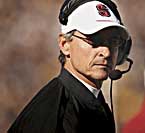Saying “the time is right for us to make a change in our football leadership,” athletics director Bob Bowlsby announced on December 4 that Walt Harris was being dismissed as head coach. Harris was in the second year of a five-year contract, and Bowlsby said he and the University are “in the process of negotiations on the terms under which we will separate.”
The announcement came within 24 hours of the 26-17 Big Game loss to Cal, and followed a 1-11 season that Bay Area sports media had described as “troubled,” “nightmarish” and “pathetic.”
“This has been a tough year, and in some measure this decision wasn’t made as a result of being 1-11, as much as it was a result of not seeing the progress in some of the real critical areas that we would have hoped for after two years,” Bowlsby said. Noting that “we are in the bottom 10 in virtually every statistical category that the NCAA keeps, on offense and on defense,” he acknowledged that empty seats in the remodeled, $90 million stadium also had been a factor in his decision. In the November 18 home game against Oregon State, Bowlsby said, there were probably 12,000 people in the stands—even though some 35,000 tickets had been sold. “One has to wonder if those people that had $45 tickets and didn’t come to the game will buy [tickets] again next year.”
Bowlsby said he hoped to name a new head coach within weeks, and that he would be looking for a “relentless recruiter,” someone with honesty, a strong work ethic and “impeccable integrity.” He added, “It would be nice to have somebody that’s had an experience here,” and indicated that he was going to talk to “anybody who has that sort of skill set and experiential background.”
When Bowlsby was hired as athletics director last summer, he saw a football program with a starting quarterback who would likely turn pro (Trent Edwards, ’06), veteran receivers and offensive linemen, and a solid defense. But as injuries piled up, the defensive line began to resemble a sieve and the lack of a running attack on offense became painfully apparent.
The only win of the season came November 11, with a 20-3 thumping of Washington that had players chanting, “We won the game! It feels good!” in the locker room. Other games had individually inspiring moments—including the blustery October 7 Saturday at Notre Dame when junior walk-on receiver Kelton Lynn snagged a wobbly halfback option pass from junior tailback Anthony Kimble and scored a 57-yard, fourth-quarter touchdown in Stanford’s 31-10 loss to the Fighting Irish. The following weekend, junior cornerback Wopamo Osaisai intercepted a pass and blazed it back 72 yards for the game’s only touchdown in the Cardinal’s 20-7 loss to Arizona on October 14.
Stanford entered the December 2 Cal game as a 29-point underdog, prompting fans—Dean of Humanities and Sciences Sharon Long among them—to wear big red “I believe. Big Game 2006” buttons. The Cardinal ran the ball effectively in the first half at Memorial Stadium, leading in first downs (11-7), rushing yards (57-33), passing yards (115-70) and possession time (20:37-9:23). True freshman receiver Richard Sherman made six catches for 81 yards, including one touchdown, and redshirt junior wide receiver Evan Moore made a glorious one-handed catch to run 51 yards into the end zone. But the Cardinal missed a key opportunity in the fourth quarter, failing to convert a Cal fumble on its 14-yard line, and also missed a field goal.
As he looked at the entire season, Bowlsby said, the most critical assessment he had to make was, “Does investing another year present the likely possibility of making substantial improvement? And if I couldn’t answer that affirmatively, which I ultimately didn’t, then I felt like it was better to make the change now than wait more time.” He said he wasn’t sure if that was “entirely fair” to Harris, then added, “But my first responsibility is fairness to our institution and to our student-athletes.”



